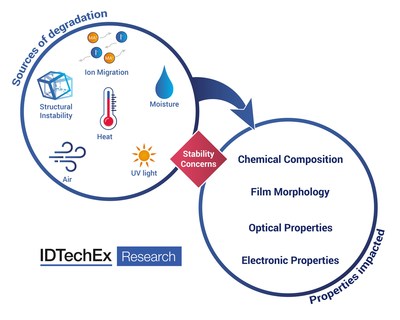Perovskite PV: IDTechEx Discusses Resolving the Stability Challenge
Perovskites refer to a family of materials with a specific material structure. The class of perovskites used in photovoltaics (PV) have a unique combination of electronic and optical properties that make it extremely well-suited to PV technology. Perovskite PV can provide similarly high-power density as silicon PV at lower cost, a fraction of the weight, and with a simpler manufacturing process. It can also be combined with silicon to create tandem cell architectures that can surpass the efficiency limits of single junction solar cells.
Efficiency gains dampened by stability concerns
Despite the demonstration of high-efficiency perovskite modules, commercial adoption has been inhibited by concerns over long-term stability. Instability has a severely damaging effect on the electronic and optical properties of the module. There exist several sources of degradation that impact the stability and longevity of a perovskite module. These can be divided into two categories – intrinsic and extrinsic. Intrinsic instability is caused by defects and the migration of ions through the cell layers. Extrinsic instability is a result of contamination from the atmosphere, such as heat, moisture, oxygen, and UV radiation.
How can the stability challenge be resolved? There are two methods. The first is to encapsulate the cell to prevent the ingress of environmental elements. The transmittance rates of oxygen and water must be extremely low, and the encapsulant material must be optically transparent to visible light and ideally non-transparent to UV light. In the IDTechEx report, "Perovskite Photovoltaics 2023-2033", different conventional and emerging encapsulation methods are identified and benchmarked by their suitability. The second method involves tuning the perovskite's chemical composition to improve the resistance of the material. As the saying goes, nothing good comes for free. Modifying the chemical composition can improve the stability of the solar cell but may impact other properties such as efficiency and absorption spectrum. Encapsulation techniques and material engineering are crucial to preventing the degradation of the perovskite film. Solving these high-value problems is a compelling commercial opportunity.
Progress and Route to Commercialization
Resolving perovskite PV stability issues is challenging, with many strategies bringing performance trade-offs or extra costs. Nevertheless, the field has come a long way in its understanding of degradation mechanisms, and substantial progress has been made. Advancements in stabilizing perovskite solar cells have helped to transition the technology from academia to industry. Several companies, such as Oxford PV and Saule Technologies, are poised to enter the unestablished perovskite PV market within the next 2-3 years, with pilot studies and trials currently in progress. For a detailed comparison of the technology readiness levels of the key industry players, emerging applications, primary information, and market forecasts for the coming decade, please visit www.IDTechEx.com/Perovskite.
Report Overview
The new IDTechEx report, "Perovskite Photovoltaics 2023-2033", gives 10-year market forecasts, key player analysis, technology benchmarking, and identification of core application areas. It examines the current status and latest trends in photovoltaic technology, supply chain, and manufacturing know-how. It also identifies the key challenges, competition, and innovation opportunities facing perovskite PV. Technical analysis and emerging trends are based on cutting-edge research and primary information from key and emerging players. This report focuses primarily on photovoltaic applications of perovskites and also provides an overview of alternative (non-photovoltaic) applications.

To find out more about this report, please visit www.IDTechEx.com/Perovskite or contact [email protected]. Downloadable sample pages are available.
About IDTechEx
IDTechEx guides your strategic business decisions through its Research, Subscription and Consultancy products, helping you profit from emerging technologies. For more information, contact [email protected] or visit www.IDTechEx.com.
Images download:
https://www.dropbox.com/sh/3hzgxrmish7hi9z/AACxbRtXw-SEDpaiCf9p18BSa?dl=0
Media Contact:
Natalie Fifield
Digital Marketing Manager
[email protected]
+44(0)1223 812300
Social Media Links:
Twitter: www.twitter.com/IDTechEx
LinkedIn: www.linkedin.com/company/IDTechEx
Facebook: www.facebook.com/IDTechExResearch
Photo: https://mma.prnewswire.com/media/1864849/IDTechEPeroveskite.jpg
Logo: https://mma.prnewswire.com/media/478371/IDTechELogo.jpg





